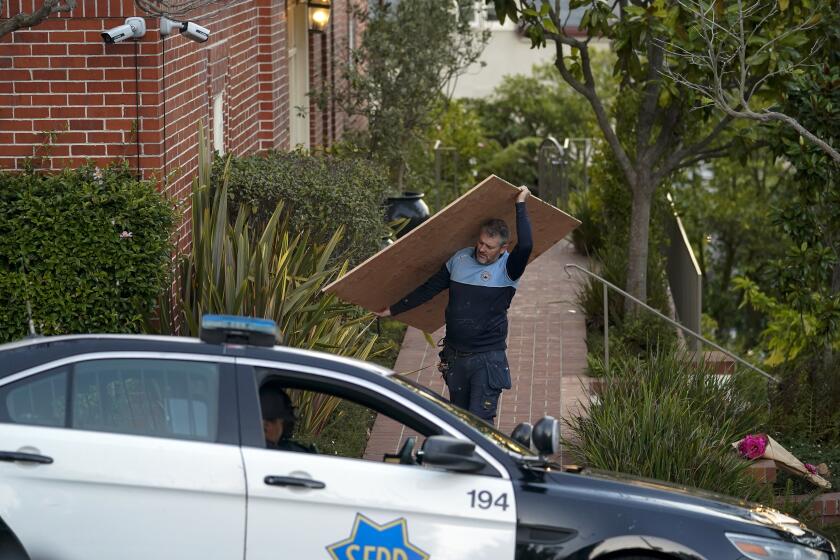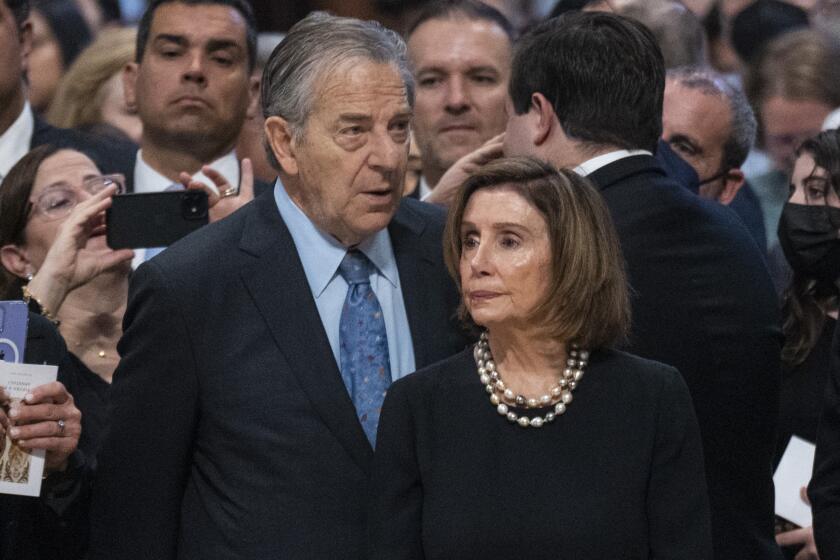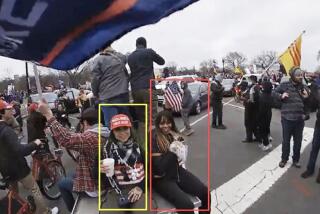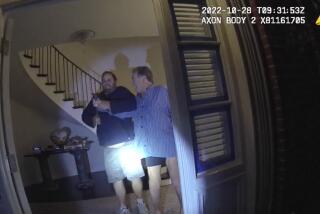Security cameras for the Pelosi home weren’t ‘actively monitored,’ Capitol Police admit
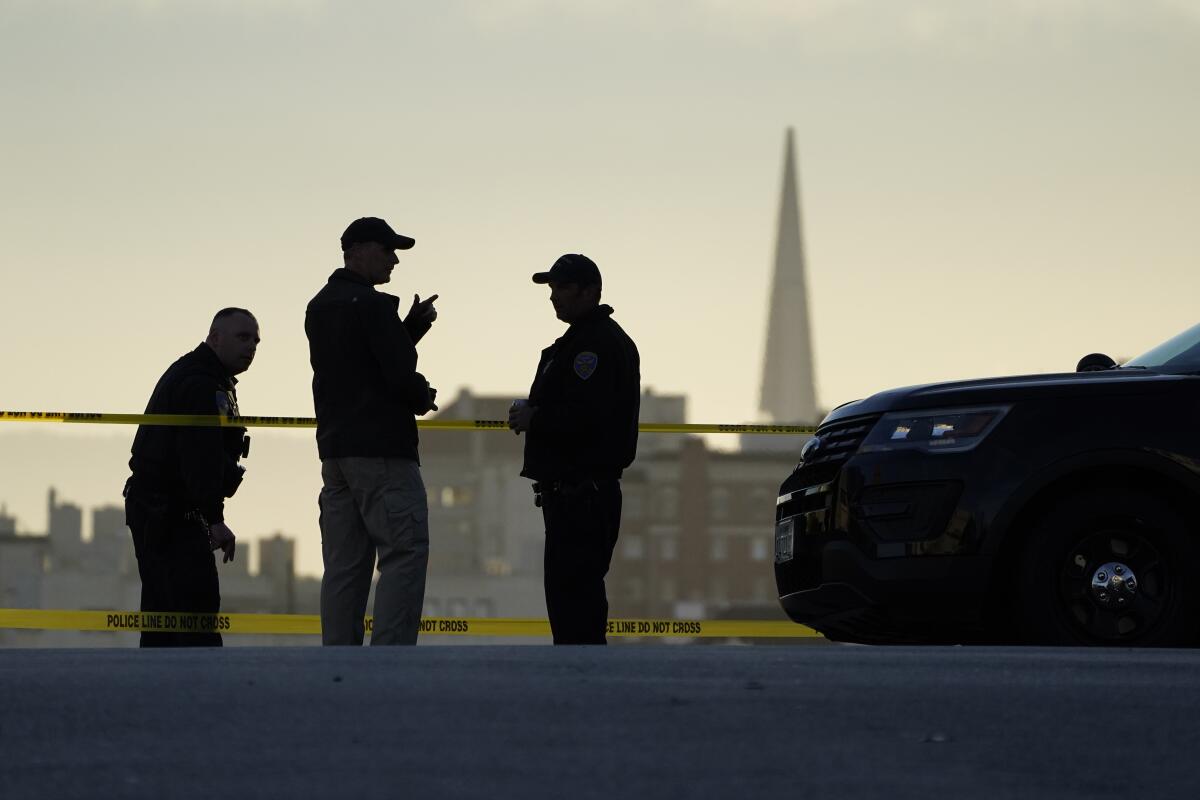
Security cameras for the San Francisco residence of House Speaker Nancy Pelosi were not actively being monitored by U.S. Capitol Police the night of a violent home-invasion attack against her husband, the government agency said Wednesday.
After reports to The Times and other outlets that a security feed existed, Capitol Police said in a statement that the cameras “are used to actively monitor the speaker’s San Francisco residence around the clock when she is there” but acknowledged that when she is in Washington, D.C., with her security detail — as she was during Friday’s break-in — the “cameras were not actively monitored.”
Officials in Washington noticed a problem at the Pelosi home only when they saw police car lights in the video feed, a law enforcement source told The Times. Details about the Capitol Police recording were first reported by the Washington Post.
Two other law enforcement sources said a police cruiser that was kept parked in front of the home after the Jan. 6, 2021, attack on the U.S. Capitol had been withdrawn sometime last year.
On Friday, a private security guard noticed a man dressed in all black and walking with a backpack near the Pelosis’ Pacific Heights home around 2 a.m.
Authorities say that man was David DePape and the bag contained zip ties, a rope and a hammer.
His goal, federal prosecutors allege, was to kidnap and torture the House speaker and then potentially move on to other high-profile targets.
David DePape pleaded not guilty to a host of charges in connection with an attack on Paul Pelosi in San Francisco and was ordered held without bail.
What he didn’t know was that Nancy Pelosi was not at home that morning, and the only person in the house was her husband, Paul Pelosi.
The speaker’s absence — along with that of her security detail — made her home a much easier target. It also has raised new questions about security measures for top officials in a time of rising political divisions and growing threats.
In a five-page letter from Rep. Zoe Lofgren (D-San Jose) to J. Thomas Manger, the chief of the Capitol Police, that was reviewed by The Times, Lofgren said the attack raised “significant questions about security protections for members of Congress, particularly those in the presidential line of succession.”
The congresswoman, who chairs the Committee on House Administration, which has oversight of the Capitol Police, had pointed questions for Manger about why the Capitol Police declined the FBI’s offer to help with security and asked the agency to “reconsider that offer.”
She asked whether the Capitol Police has any policies that place officers in regional or field offices and if so, whether those plans were in place and followed the night of the attack on Paul Pelosi.
Lofgren questioned whether the Capitol Police regularly reviews physical security details for the speaker of the House and the president pro tempore of the Senate and whether the agency collaborates with the Secret Service on “appropriate physical security requirements to protect these officials.”
“The department has previously reported to the committee that the speaker receives the most threats of any member of Congress,” Lofgren wrote, adding that after the Jan. 6 attacks, there have been persistent warnings from the National Terrorism Advisory System of increased threats of political violence. Based on that, Lofgren asked whether the Capitol Police had a plan to extend coverage to the spouses and family of the congressional leaders in the presidential line of succession — and if the agency didn’t, she wanted to know why.
Following Lofgren’s queries, Capitol Police are conducting an internal investigation and review of security arrangements.
The attacker who confronted Nancy Pelosi’s husband Paul in their home yelled, ‘Where is Nancy?’ Read our full coverage.
A law enforcement source told The Times that San Francisco police regularly patrol the area but don’t have a permanent station at the Pelosis’ home.
Prosecutors said DePape smashed through the glass patio door of the Pelosis’ home around 2 a.m. Friday.
It is unclear whether any alarms at the house sounded, but officials said after breaking in, DePape managed to get to the second floor.
There, he found Paul Pelosi, 82, sleeping and repeatedly shouted, “Where’s Nancy?” officials said.
Realizing the potential danger, Pelosi managed to make a quick, surreptitious phone call to 911 and left the line open, authorities said. A 911 dispatcher realized something was seriously wrong and immediately sent police to the address. Officers were told there was a man inside the home named David, whom Pelosi did not know.
When an officer arrived at Pelosi’s door and asked, “What is going on here?” DePape and Pelosi were wrestling with a hammer, authorities said. Then DePape “wrenched” it from Pelosi, “stepped back and lunged at Mr. Pelosi,” striking him in the head with “full force with the hammer” and knocking him unconscious, according to court records seeking to deny bail for DePape.
The officers disarmed DePape, according to the motion, while Pelosi lay in a pool of blood for three minutes before regaining consciousness.
DePape told an officer at the scene that “he acted alone,” the motion says.
Federal charges against David DePape include assault on a family member of a U.S. official and attempted kidnapping of a federal official.
DePape later revealed to San Francisco police that he planned to kidnap Nancy Pelosi and break her kneecaps, calling her the “leader of the pack” of lies told by the Democratic Party, authorities said.
In the course of his police interview, DePape told investigators “that by breaking Nancy’s kneecaps, she would then have to be wheeled into Congress, which would show other members of Congress there were consequences to actions.”
“I came here to have a little chat with his wife,” DePape added, referring to Paul Pelosi, according to court documents revealed Tuesday. “I didn’t really want to hurt him, but you know, this was a suicide mission.”
Prosecutors allege DePape had other targets in mind — including a Bay Area professor and prominent state and federal politicians and their families — when he broke into the Pelosis’ home. He planned to wait for the speaker to return, those documents say.
The Pelosi attack has further heightened concerns about attacks on political figures after the Jan. 6 insurrection at the U.S. Capitol.
In a statement, Nancy Pelosi’s office said her husband is making ‘steady progress’ but released no other specific details.
There were 9,625 threats against members of Congress and their families last year, according to the Capitol Police — more than twice as many as in 2017. A joint project by the Anti-Defamation League and Princeton University tracked 400 incidents of harassment against local-level election, health and education officials in 43 states from January 2020 until mid-September this year.
Capitol Police said the agency has launched a review of security in the wake of the Pelosi incident.
“We believe today’s political climate calls for more resources to provide additional layers of physical security for Members of Congress,” Chief Manger said in a statement. “This plan would include an emphasis on adding redundancies to the measures that are already in place for congressional leadership. Hopefully you can understand that we cannot disclose the details about these improvements because our country cannot afford to make it easier for any potential bad actors.
“During this time of heightened political tension, we continue to monitor thousands of cases across the country in an effort to stop potential threats before they make headlines,” he added.
David DePape, 42, has been arrested in connection with a violent attack on U.S. House Speaker Nancy Pelosi’s husband, Paul Pelosi.
On Monday, the Department of Justice filed federal assault and kidnapping charges against DePape, and San Francisco Dist. Atty. Brooke Jenkins charged DePape with attempted murder and assault with a deadly weapon, among other crimes.
Police have not offered a motive for the attack. But Jenkins said Monday that based on DePape’s statements and comments to Pelosi, it “was politically motivated.”
“It’s very sad to see that we are once again at the point in history where people believe that it’s OK to express their political sentiments through violence,” she said. “It demonstrates that we have to calm things down. We have to decide that we’re going to be more respectful as an American society.”
More to Read
Sign up for Essential California
The most important California stories and recommendations in your inbox every morning.
You may occasionally receive promotional content from the Los Angeles Times.


